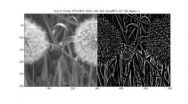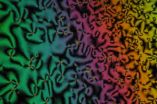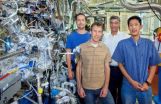(Press-News.org) PHILADELPHIA –- Physicists and neuroscientists from the University of Pennsylvania have linked the cell structure of the retina to the light and dark contrasts of the natural world, demonstrating the likelihood that the neural pathways humans use for seeing are adapted to best capture the world around us.
Researchers found that retinal ganglion cells that see darkness are more numerous and cluster closer together than those that see light, corresponding to the fact that the natural world contains more dark spots than light. Now physicists, and not just pessimists, see the world for the dark place it is.
The results suggest that the brain's separation of retinal circuitry into off and on mosaics that separately process dark and bright spots allows for structural adaptation to the natural scenes humans must see.
The team took the study a step further by constructing artificial images that matched the characteristics of the natural world and by testing what sorts of off and on mosaics best represented information from these images. According to the authors, the total flow of information peaked for mosaics with more densely clustered off cells, as in the human retina, suggesting that human vision has evolved to efficiently represent visual information in the natural world.
Researchers looked at the physiology of the retinal ganglion cells whose job it is to respond to a dark spot on a brighter background, simply called off cells, wondering why the brain would have clusters of off cells and not an even distribution across the retina. In addition to being more numerous and branching together in dense, bushy clusters, they also have smaller dendritic fields than the cells responsible for seeing light spots. By branching together more densely in clusters, they collect more synapses per visual angle. Thus, researchers concluded that the retina devotes more resources to processing dark contrasts, a natural capability reflected in the fact that there is more dark information in the world around us.
Researchers tested the hypothesis by measuring the spatial contrasts in natural images and quantifying the distribution of lightness and darkness. At all scales, the authors found that natural images contain relatively more dark contrasts than light.
"Photoreceptors respond to light," Vijay Balasubramanian, professor of physics and the study's lead author, said. "But a couple of layers deeper down in the retina, cells are responding to changes and differences in the amount of light across the image. The eye is not a digital camera, recording little pixels. The eye doesn't do that. The eye tells the brain that there are differences in light between neighboring points. The brain learns about contrast. And in this case, there is about twice as much brain activity responding to darker spots."
The team confirmed this across a range of spatial scales and traced the origin of this phenomenon to the statistical structure of natural scenes. Researchers showed that the optimal mosaics for encoding natural images are also asymmetric, with off elements smaller and more numerous, thus matching retinal structure. Finally, the concentration of synapses within a dendritic field matches the information content, suggesting a simple principle to connect a concrete fact of neuroanatomy with the abstract concept of "information": equal synapses for equal bits.
Researchers were interested in how the visual system is adapted to the physical structure of the world, an assumption that makes sense from an evolutionary standpoint. The physics of the natural world should correspond to the processing capabilities of the brain and there are many observable incidences of this phenomenon in the human and animal world. For example, frogs eat flies. That fact predicted that frog's eye contains "fly detectors." Flies, in turn, track potential mates in mid-air, predicting specialized neural fly circuits that detect other flies.
This study demonstrates the opposite case. Here, a particular feature of the human neural circuitry predicted a surprising property of the visual environment.
INFORMATION:
The study was conducted by Balasubramanian of the Department of Physics and Astronomy at Penn and the Department of Neuroscience at the University of Pennsylvania School of Medicine, Charles Ratliff of the Department of Physics and Astronomy at Penn and Bart Borghuis, YenHong Kao and Peter Sterling of the Department of Neuroscience at Penn Med.
The study, published in the Proceedings of the National Academy of Sciences, was supported by the National Institutes of Health and the National Science Foundation.
The world is full of darkness, reflected in the physiology of the human retina, Penn researchers say
2010-10-06
ELSE PRESS RELEASES FROM THIS DATE:
Georgia Tech researchers design system to trace call paths across multiple networks
2010-10-06
Phishing scams are making the leap from email to the world's voice systems, and a team of researchers in the Georgia Tech College of Computing has found a way to tag fraudulent calls with a digital "fingerprint" that will help separate legitimate calls from phone scams.
Voice phishing (or "vishing") has become much more prevalent with the advent of cellular and voice IP (VoIP) networks, which enable criminals both to route calls through multiple networks to avoid detection and to fake caller ID information. However each network through which a call is routed leaves its ...
Researcher finds top reasons for Facebook unfriending
2010-10-06
DENVER (October 5, 2010) - With over 500 million users worldwide, Facebook has become a global phenomenon, a vast cyber neighborhood where friends meet to share photos, news and gossip.
But when those relationships sour, another phenomenon often occurs – unfriending.
In what may be the first comprehensive study of its kind, a University of Colorado Denver Business School student has revealed the top reasons for Facebook unfriending, who is unfriended and how they react to being unfriended.
"Researchers spend a lot of time examining how people form friendships online ...
A tracking device that fits on the head of a pin
2010-10-06
Optical gyroscopes, also known as rotation sensors, are widely used as a navigational tool in vehicles from ships to airplanes, measuring the rotation rates of a vehicle on three axes to evaluate its exact position and orientation. Prof. Koby Scheuer of Tel Aviv University's School of Physical Engineering is now scaling down this crucial sensing technology for use in smartphones, medical equipment and more futuristic technologies.
Working in collaboration with Israel's Department of Defense, Prof. Scheuer and his team of researchers have developed nano-sized optical gyroscopes ...
Better cholesterol drugs may follow Saint Louis University researcher's breakthrough
2010-10-06
ST. LOUIS – Thanks to a discovery by a Saint Louis University researcher, scientists have identified an important microRNA that may allow us to better control cholesterol levels in blood.
Led by Ángel Baldán, Ph.D., assistant professor of biochemistry and molecular biology at Saint Louis University and published in a recent issue of Proceedings of the National Academy of Sciences of the United States of America, the study found that the microRNA miR-33, may be key to controlling HDL, or "good" cholesterol levels.
In the U.S., heart attack, stroke, and peripheral ...
October 2010 issue of the Bulletin of the Seismological Society of America
2010-10-06
Causal relationship between rainfall and earthquakes detailed
This review article explores natural crustal earthquakes associated with the elements of the hydrologic cycle, which describes the continuous movement of water on, above and below the surface of the Earth, including hurricanes and typhoons. The theory of hydroseismicity, first articulated in 1987, attributes most intraplate and near-intraplate earthquakes, to the dynamics of the hydrological cycle.
The Hydroseismicity hypothesis suggests variations in rainfall affect pore-fluid pressure at depth and can ...
Sociologists find lowest-paid women suffer most from motherhood penalty
2010-10-06
WASHINGTON, DC, October 5, 2010 — In a study of earnings inequality among white women, researchers at the University of Massachusetts Amherst find that having children reduces women's earnings, even among workers with comparable qualifications, experience, work hours and jobs. While women at all income levels suffer negative earnings consequences from having children, the lowest-paid women lose the most from motherhood. This earnings penalty ranges from 15 percent per child among low-wage workers to about 4 percent among the highly paid. The findings are published in the ...
Scripps Research scientists shed light on how serotonin works
2010-10-06
JUPITER, FL, October 5, 2010 - Scripps Research Institute scientists have shown for the first time that the neurotransmitter serotonin uses a specialized signaling pathway to mediate biological functions that are distinct from the signaling pathways used by hallucinogenic substances. The new findings could have a profound effect on the development of new therapies for a number of disorders, including schizophrenia and depression.
The study was published in the October 6, 2010 issue of the Journal of Neuroscience.
Serotonin has tremendous influence over several brain ...
New type of liquid crystal promises to improve performance of digital displays
2010-10-06
Chemists at Vanderbilt University have created a new class of liquid crystals with unique electrical properties that could improve the performance of digital displays used on everything from digital watches to flat panel televisions.
The achievement, which is the result of more than five years of effort, is described by Professor of Chemistry Piotr Kaszynski and graduate student Bryan Ringstrand in a pair of articles published online on Sept. 24 and Sept. 28 in the Journal of Materials Chemistry.
"We have created liquid crystals with an unprecedented electric ...
San Diego Supercomputer Center participates in first 'Census of Marine Life'
2010-10-06
After a decade of joint work involving 2,700 researchers from 80 countries, the world's scientists – as well as the general public – can now access the Census of Marine Life, which provides the first in-depth look at the more than 120,000 diverse species which inhabit our oceans.
The Census of Marine Life initiative, started in 2000, is the result of one of the largest scientific collaborations ever conducted , the result of more than 540 expeditions and 9,000 days at sea, plus more than 2,600 academic papers published during that period.
The just-released census paints ...
Fuel cells in operation: A closer look
2010-10-06
Measuring a fuel cell's overall performance is relatively easy, but measuring its components individually as they work together is a challenge. That's because one of the best experimental techniques for investigating the details of an electrochemical device while it's operating is x-ray photoelectron spectroscopy (XPS). Traditional XPS works only in a vacuum, while fuel cells need gases under pressure to function.
Now a team of scientists from the University of Maryland, the U.S. Department of Energy's Sandia National Laboratories, and DOE's Lawrence Berkeley National ...


